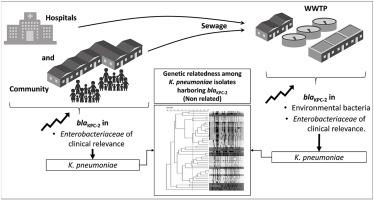Journal of Environmental Management ( IF 8.7 ) Pub Date : 2020-07-10 , DOI: 10.1016/j.jenvman.2020.111046 E A Rodríguez 1 , A M Aristizábal-Hoyos 1 , S Morales-Zapata 1 , L Arias 2 , J N Jiménez 1

|
Wastewater treatment plants (WWTPs) are considered to be a reservoir and a source of bacterial resistance. Worryingly, the presence of carbapenem-resistant Gram-negative bacilli (CRGNB) in WWTPs has recently been reported, but there are still many research gaps regarding its emergence and impact. The distribution of CRGNB in the different stages of a WWTP in Colombia and the relationship between the physicochemical factors involved with their presence are described in this paper. Additionally, given the impact on public health, the CRGNB detected were compared with isolates previously found in hospital patients. Residual water samples were taken from five different stages of a WWTP between January and July 2017. A total of 390 GNB were isolated, and a significant frequency of CRGNB harboring blaKPC-2 (38.2%, n = 149/390) was detected, of which 57% were Enterobacteriaceae, 41.6% Aeromonadaceae, and 1.3% Pseudomonadaceae. The Enterobacteriaceae were more frequent in the raw effluent compared to the Aeromonadaceae, which in turn were more prevalent in the recycled activated sludge and final effluent. Environmental variables such as pH, oxygen, chemical oxygen demand, and temperature were significantly correlated with the quantification of carbapenem-resistant Enterobacteriaceae (CRE) at specific points in the WWTP. Interestingly, isolated K. pneumoniae harboring blaKPC-2 from the WWTPs were diverse and did not relate genetically to the hospital strains with which they were compared. In conclusion, these results confirm the worrying scenario of the dissemination and persistence of emerging contaminants such as CRGNB harboring blaKPC-2, and reinforce the need to establish strategies aimed at containing this problem using multifocal interventions.
中文翻译:

在废水处理厂的不同阶段中,带有blaKPC-2的革兰氏阴性菌的高频率:医院环境之外对碳青霉烯类耐药的成功机制。
废水处理厂(WWTP)被认为是细菌的储存库和耐药源。令人担忧的是,最近已经报道了污水处理厂中对碳青霉烯类耐药的革兰氏阴性杆菌(CRGNB)的存在,但在其出现和影响方面仍存在许多研究空白。本文描述了CRGNB在哥伦比亚污水处理厂不同阶段的分布以及与它们存在有关的物理化学因素之间的关系。此外,考虑到对公共卫生的影响,将检测到的CRGNB与以前在医院患者中发现的分离株进行了比较。在2017年1月至2017年7月期间,从污水处理厂的五个不同阶段采集了残留的水样。总共分离出390个GNB,并且有相当数量的CRGNB携带bla KPC-2检出率(38.2%,n = 149/390),其中肠杆菌科57%,气单胞菌科41.6%和假单胞菌科1.3%。的肠杆菌科细菌相比,分别在原料流出物更频繁Aeromonadaceae,而后者又是在再循环的活性污泥和最终流出物更为普遍。pH,氧气,化学需氧量和温度等环境变量与WWTP特定点上耐碳青霉烯的肠杆菌科(CRE)的定量显着相关。有趣的是,带有bla KPC-2的分离的肺炎克雷伯菌污水处理厂的粪便种类繁多,与与其进行比较的医院菌株在遗传上不相关。总之,这些结果证实了令人担忧的情况,即诸如bla KPC-2的CRGNB之类的新兴污染物的传播和持久性,并强化了建立旨在使用多焦点干预措施解决该问题的策略的必要性。



























 京公网安备 11010802027423号
京公网安备 11010802027423号